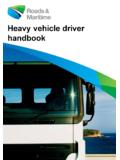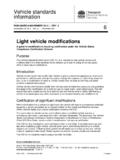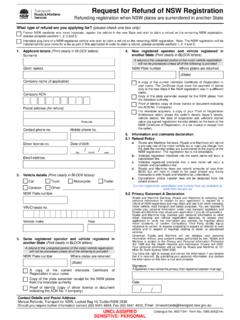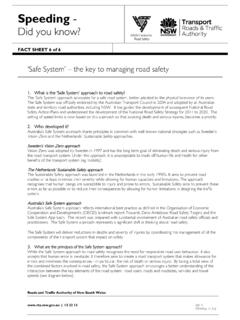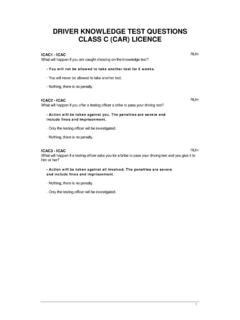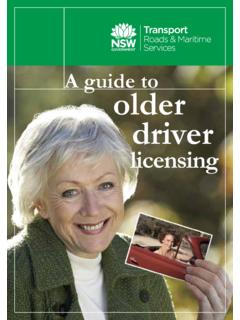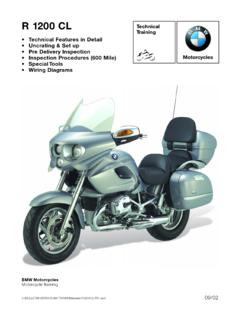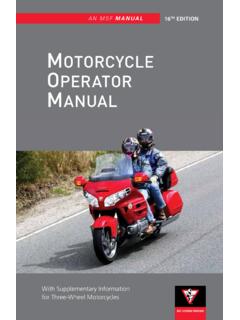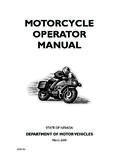Transcription of Motorcycle riders’ handbook - Roads and Maritime Services
1 Motorcycle riders '. handbook This handbook is only an interpretation of the law made easy to understand by using plain English. Laws change often so make sure you have the most recent handbook available on the Roads & Maritime website at OTHER Roads & Maritime PUBLICATIONS FOR. Motorcycle riders . Braking habits Road Users' handbook Motorcycle ABS brochure Motorcycle riders ' handbook 1. Introduction Motorcycling can be fun, economical and safe. It may reduce your carbon footprint. However, Motorcycle riding can also be hazardous. Motorcycle riders are less protected than car drivers and have a greater chance of being killed or injured in a crash. You can become a safe rider through acquiring the necessary skills and understanding of the road environment, by always being alert and defensive and by accepting that the prime responsibility for your safety on the road is yours. Our procedures for getting a Motorcycle rider licence are designed to help you become a safe rider.
2 The Motorcycle riders ' handbook , our training programs and the testing procedures are designed to get you confident in the fundamental skills. We trust you will maintain and further develop these skills. This handbook contains important information about riding techniques, how to cope with hazards and some road rules for motorcycles . Please read it carefully. Enjoy your riding, but above all, ride to survive. 2 Motorcycle riders ' handbook Contents 1. HOW TO USE THIS handbook .. 6. 2. LICENSING.. 8. Obligations of licence holders .. 8. Bribing people is against the law.. 8. Having the correct licence.. 9. Riding without a licence.. 9. Motorcycle Graduated Licensing Scheme.. 10. Licence types Learner rider licence .. 12. Provisional P1 rider licence.. 14. Provisional P2 rider licence.. 16. How to get a rider licence .. 18. Rider training courses .. 20. Summary What you should know about licensing .. 21. 3. RIDER MANAGEMENT.
3 22. Concentration.. 22. Protective clothing.. 24. Summary What you should know about rider management.. 28. 4. SAFE RIDING.. 30. Observation Scanning .. 30. Speed management Maintain space to the front.. 32. Maintain space when stopped.. 33. Maintain space behind you .. 34. Reduce speed.. 34. Road positioning Space, surface and sight.. 35. Examples of buffering .. 38. Vehicles following.. 40. Vision.. 40. Blind crests .. 41. Multi-laned Roads .. 42. Overtaking.. 44. Turns at intersections.. 46. Positioning for curves and bends.. 47. The danger of exiting wide.. 48. Planning a series of curves.. 50. Motorcycle riders ' handbook 3. Riding in groups.. 51. Making decisions Gap selection.. 52. Hazard perception Responding to hazards .. 53. Examples of situation that require a response.. 54. Basic riding techniques Riding posture.. 55. Braking technique .. 55. The five key points of riding posture apply to all types of motorcycles .
4 56. Steering technique.. 58. Leaning with the Motorcycle in a curve.. 59. Summary What you should know about safe riding.. 60. 5. ROAD RULES FOR Motorcycle riders .. 61. Motorcycle specific road rules and signs Riding on a Motorcycle .. 61. Helmets.. 61. Keeping left .. 61. Hand signals .. 62. Lending or borrowing a Motorcycle .. 62. Motorcycle warning signs.. 63. Riding at night .. 63. Carrying passengers and loads Motorcycle passengers .. 64. Sidecar passengers.. 64. Loading .. 65. Towing and being towed .. 65. Parking Motorcycle parking.. 66. Restrictions on where to ride Road and road related areas.. 66. Riding on footpaths .. 67. Transit lanes .. 67. Bus lanes.. 67. Bus only lanes.. 67. T-way lanes.. 67. Bicycle lanes .. 67. Summary What you should know about road rules for Motorcycle riders .. 68. 4 Motorcycle riders ' handbook 6. Motorcycle SUITABILITY FOR SAFE ROAD USE .. 70. Number plates.. 70. Suitable for safe road use.
5 71. Summary What you should know about Motorcycle suitability for safe road use.. 73. 7. PENALTIES.. 74. Traffic offences.. 74. Demerit points for traffic offences .. 74. Speeding offences.. 74. Over the speed limit by 30 km/h and 45 km/h.. 74. Other serious riding offences.. 75. Negligent or dangerous riding causing injury or death.. 75. Street or drag racing .. 76. Drink riding.. 76. Riding without a licence.. 76. Fine defaults .. 77. Summary What you should know about penalties .. 78. 8. GLOSSARY.. 79. 9. INDEX.. 83. Motorcycle riders ' handbook 5. 1. How to use this handbook The Motorcycle riders ' handbook is a comprehensive information source for the rules and regulations, information and advice that you need to ride safely on NSW Roads . Learners must read it thoroughly to be able to get a learner licence. For experienced riders the handbook offers a way to check current road rules, or to understand more about road safety and low risk riding.
6 To make it easy to find what you want to know the handbook is divided into sections. At the end of each section is a summary that helps you remember or revise key points. To help test your knowledge there are also sample sets of questions taken from the Driver Knowledge Test. In addition, you will find an overview of penalties for traffic offences. The back of the handbook contains the answers for each section, an index and glossary of terms. Other Roads & Maritime publications are shown on page 1. Most are available at motor registries and Service NSW Centres or on the website at Do not forget to study the Road Users' handbook just as carefully. It contains the general road rule information you need to know to pass the knowledge test. SECTION 2: LICENCES. This section is essential reading for people wanting to obtain a licence to ride on NSW Roads . SECTION 2 EXPLAINS: The licensing system. The various steps you must take to obtain a full licence.
7 The Rider Knowledge Test. Information on eyesight tests and proof of identity. The obligations of licence holders. SECTION 3: RIDER MANAGEMENT. This section considers in detail how to increase your enjoyment and safety when riding on the road and how to take responsibility for your own wellbeing. SECTION 3 EXPLAINS: Recognising and managing fatigue. Alcohol and other drugs. Protective clothing. 6. 1. SECTION 4: SAFE RIDING. This section provides key safe riding behaviours which are useful for all riders . SECTION 4 EXPLAINS: Observation, speed management and road positioning. The importance of crash avoidance space. SECTION 5: GENERAL ROAD RULES. Every motorcyclist needs to know the rules that apply to riding. This section offers comprehensive coverage of the main rules governing motorcycles . SECTION 5 EXPLAINS: Motorcycle specific road rules and signs. Carrying passengers and loads. Restrictions on where to ride.
8 Parking restrictions. SECTION 6: Motorcycle SUITABILITY FOR SAFE ROAD USE. All motorcycles using NSW Roads must be registered and suitable for safe road use. This section provides a brief explanation of Motorcycle safety and registration requirements. SECTION 6 EXPLAINS: Registering your Motorcycle . Requirements for displaying number plates. Tyres (pressure, tread and wear). Defect notices on suitable for safe road use motorcycles . SECTION 7: PENALTIES. This section provides an overview of the penalties for traffic offences. SECTION 7 EXPLAINS: The penalties for exceeding the speed limit, including demerit points, fines and licence suspension. The implications of serious, negligent and dangerous riding offences. How street and drag racing penalties can result in the loss of a Motorcycle . The implications of not settling a traffic fine. The penalties for drink riding and unlicensed riding. 7. 2. Licensing Think of your licence as a contract', or an agreement between you as a rider and the rest of society.
9 Roads and Maritime and the NSW Police Force administer this contract on behalf of the people of NSW. When you get your licence, look after it. Do not abuse it or allow it to be misused. There are penalties if you fraudulently alter, use or lend a licence to another person or allow a licence to be used by another person. OBLIGATIONS OF LICENCE HOLDERS. The State provides the Roads for riders to use if they meet certain conditions. riders must: Show they understand the road rules, most of which are written in this and the Road Users' handbook in plain English. Show they understand society's concerns to reduce the impact of traffic on the environment and to use the road system efficiently. Show the skills necessary to ride safely. Obey the laws and ride responsibly. Pay a licence fee which goes towards maintaining the system. The contract can be broken by significant traffic offences which cause inconvenience, costs or suffering to others.
10 These offences carry penalties such as fines, licence cancellation, disqualification or suspension or, in extreme cases, imprisonment. BRIBING PEOPLE IS AGAINST THE LAW. It is illegal to offer, request or accept gifts or other favours in order to get a licence without passing the required tests. Penalties are severe and include fines and imprisonment. All cases of corruption will be investigated and strong action will be taken against all those involved. The only licence fees and charges you have to pay are set by Roads &. Maritime . Do not pay any more or offer to pay more to get your licence. If you know or believe someone has received, or is about to receive, a NSW licence by offering, or responding to a request for a bribe or if you suspect or know of any other corruption involving a Roads & Maritime 8 Motorcycle riders ' handbook 2. employee telephone Roads and Maritime on 1800 043 642 (free call) or the Independent Commission Against Corruption (ICAC) on (02) 8281 5999.

